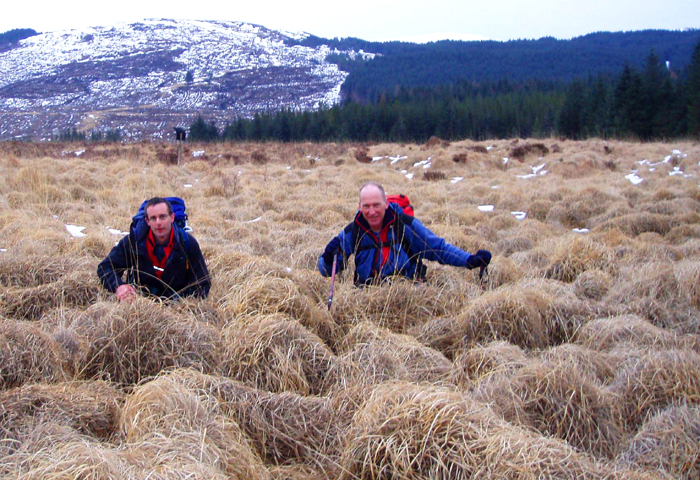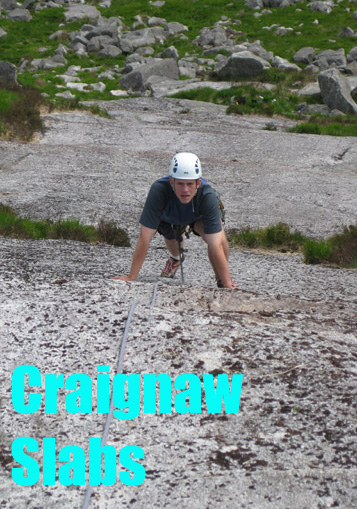
Craignaw is a great wee rocky hill in the middle of the Galloway Hills, with some of the best ice-climbing in southern Scotland on its eastern flanks. There is also now a wealth of rock-climbing on the hill, spread over three very different areas. This page deals with the recently developed climbing on the slabs at the north-east side of the mountain.
There is also lots of good winter climbing on Craignaw for which we have a separate page.
Other areas on Craignaw include:-
Memorial Crag Great steep and hard routes on a wee crag just under the summit.
Snibe Hill Short routes on a disjointed buttress at the southern end of the hill.
Craignaw Slabs
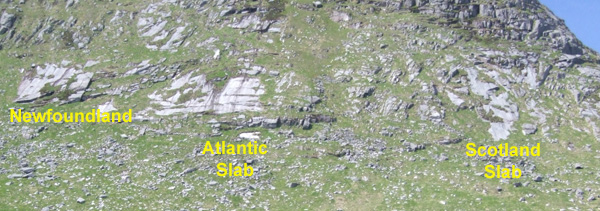
The Craignaw slabs lie low down on the northeast end of Craignaw, just a short detour from the approach to the excellent crags on the Dungeon Hill. Scotland Slab is roughly at Grid Reference NX463838. Approach the slabs as for the Dungeon crags, in about 30 minutes across the Silver Flowe from Backhill of Bush bothy. The first route here was on Scotland Slab, named for the rough resemblance of the upper slab to a map of Scotland, and the remaining slabs take their names from the rough geography of the area.
All the slabs are relatively low angled granite with occasional steps and overlaps. Rock quality is impeccable and although there is some moss on the slabs it does not detract from the climbing. Protection is either sparse or very sparse, but the belays are generally good. A 60m rope is highly recommended, or even essential. The slabs all need maybe four or five days to dry after persistent rain. The grades vary from strange to very strange, second opinions would be very welcome.!
Newfoundland
The rightmost slab gives some of the most un-gradeable routes in Scotland, let alone Galloway. Maybe they are just boulder problems with long walk-offs! Descents are possible either side.
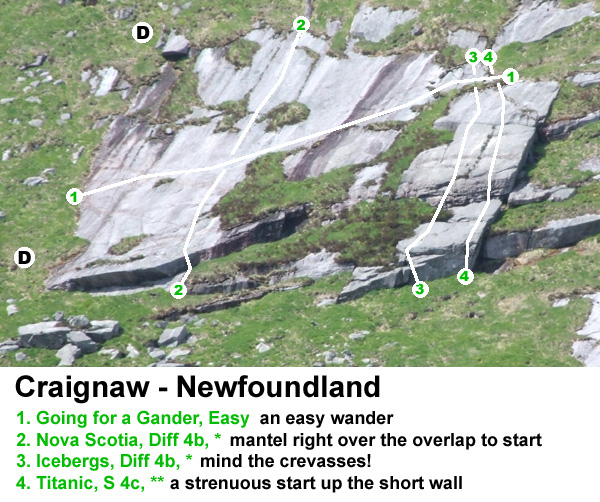
Going for a Gander, Easy! 100m+
Crosses the slab at two thirds height in either direction - the crux is stepping over the wet streak - a useful descent.
Nova Scotia, Diff 4b *, 60m, First Ascent John Biggar and Ian Brown, 3rd June 2009
Climbs the left hand side of the slab, the best start being 3m left of an obvious vertical crack in the lowest overlap (runner), with a St. Andrews Cross etched in veined relief on the slab above and left (hence the name). Make a tricky mantelshelf or rockover move leftwards onto the slab, or climb the crack. Continue easily up the middle slab to an overlap and runners at 40m, then finish up the slightly steeper top slab on nice pockets.
Icebergs, Diff 4b *, 50m, First Ascent Ian Brown and John Biggar, 3rd June 2009
Climbs the right hand side of the slabs about 5m left of Titanic. The crux "flop" start will be at least a grade easier if climbed with a full layer of fleece rather than a T-shirt and shorts! Start at a flake with a finger crack behind it. From the top of this flake make an awkward mantelshelf /flop over onto the slab above. Recover and climb the fine second tier to reach the main slab. Walk up this crossing two crevasses, then continue climbing upwards and leftwards to a hidden belay.
Titanic, Severe 4c **, 50m, First Ascent John Biggar and Ian Brown, 3rd June 2009
At the right hand end of the crag is an obvious arête. This route climbs the steep wall about one metre left to a huge jug, then onto the slab. Cross the two crevasses above and step onto the fine 4m wall above the second one. Continue up the right hand edge of the slab above before trending left to belay.
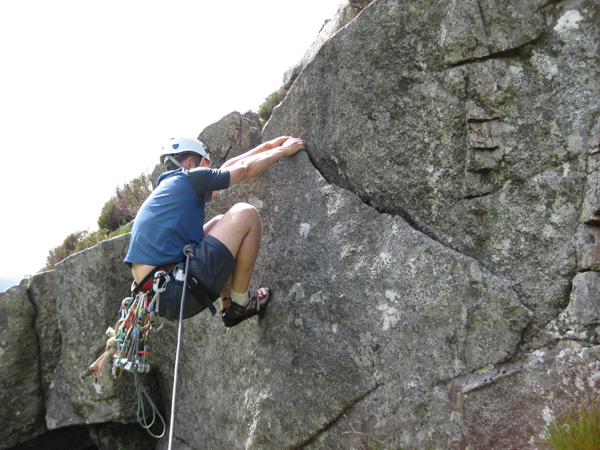
Ian Brown tries to stay cool on the awkward mantleshelf that kicks off Icebergs, Newfoundland Slab.
Atlantic Slab
The middle slab is unfortunately too low an angle to give any proper climbing, but can be climbed anywhere at Easy or Moderate.

Scotland Slab
On the right is a slab bearing some resemblance to a map of Scotland. It steepens from easy strolling on a roughly 35º slab at the base in deepest Cumbria to satisfying slab climbing at nearly 50º in Sutherland. The route still has some lichen on the easier sections, but the hardest moves have been cleaned.

The Road to Wrath, HS 4a **, 100m, First ascent L. Biggar, J. Biggar, J. Kinnaird, 25th June 2006
1. 50m 3c. From the lowest point of the slab climb easily up and right to cracks and runners at 30m (The Border). Continue more steeply straight up between two grass patches, then traverse leftwards to belay on the lower rocks of the upper slab, just west of Glasgow.
2. 50m 4a. Step over the overlap and traverse further leftwards to reach a thin crack through the steeper slab above. Climb this crack for about 5 metres before a traverse can be made back right to Inverness. Make a tenuous move to a good pocket here then up diagonally left to Cape Wrath. Belay using a cracked block a few metres up and left. (The direct line up the A9 from Glasgow to Inverness is also good, but a very unprotected lead).
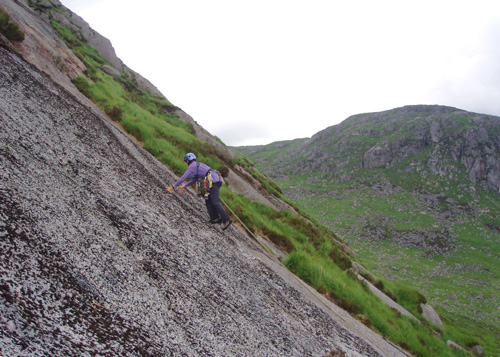
Linda Biggar about to reach The Border on the first ascent of the Road to Wrath, June 2006. The nearby Dungeon Hill Crags can be seen in the background.
North Sea Slab
The foot of this slab is about 30 or 40m right of the mid-height on Scotland Slab. There is just one route on this slab so far and the top 5 metres could do with being a bit cleaner before anyone makes another ascent. The main lower slab is very nice although unprotected and the finish will be good when cleaner - indeed the route will probably be only Severe once properly hoovered.
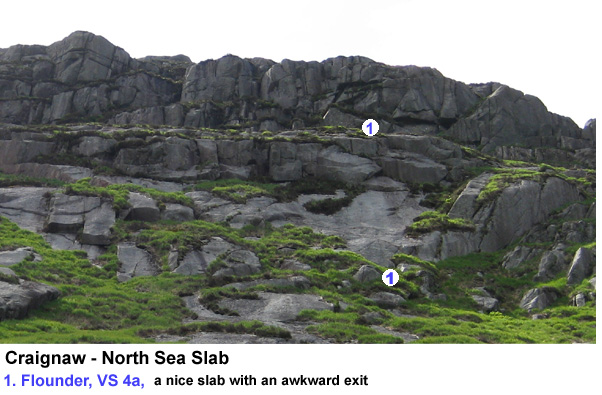
Flounder, VS 4a, 45m, First Ascent John Biggar and Ian Brown, 3rd June 2009
Start at the very toe of the slab and climb the pleasant and easy but unprotected lower slabs to runners at 20m. Continue up towards the obvious triangular niche and enter it from the left. Flounder awkwardly up and leftwards (currently very grassy/mossy) to eventually reach block belays on a large grass terrace.
Links
There is more climbing on Craignaw at Snibe Hill. and at Memorial Crag (links open new pages) and some very good Winter climbs on Craignaw .
There are some great rock climbs on the neighbouring Dungeon of Buchan buttresses, including the longest routes in southern Scotland.
Pictured Below :- Giant tussock grass in Galloway, Winter 2006. Known locally as "Dougals" (Just think of that wee dog in the Magic Roundabout...) We found these ones on the way across the Silver Flowe towards Craignaw, they were the deepest yet!
